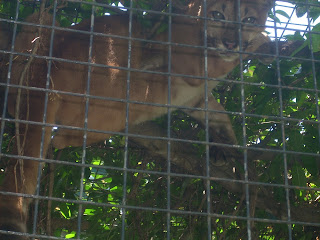 |
| The leaf of this lily is said to be strong enough to hold a baby. It is used in some Hindu ceremonies to eat out of. |
So going to the museum was really a pleasurable experience since there I got a real education and an opportunity to view their wide range of animals and birds, all stuffed of course.
For example, while I knew they had monkeys, I had no idea that they had so many varieties including one called the howler monkey which has a swollen throat and neck which allows it to make the loudest noise known to man, louder than even the elephant. And while I always thought that all reptiles ate us, I learnt that the Caiman is really harmless except for the huge Black caiman, found only here, which grows to 12 feet and is the only one aggressive to man.
Interestingly, while sloths are known to have three toes on the hind legs, the only two toed sloths are found in Guyana.
 |
| Colourful macaws at the zoo |
Anyway I saw a large variety of their birds at the zoo (no cock of the rock though) but the macaws are quite colorful.
And would you believe Guyana has the largest fresh water fish ever discovered? (I would have expected that to have been found in the Nile or the Amazon river). That is the Arapaima which grows up to 15 feet.
They also have a turtle with a flat head and neck. Weird looking creature. It only grows up to 18 inches however.
Seriously though, if you are from one of the Caricom islands, you really need to visit their zoo and museum to appreciate the difference.





No comments:
Post a Comment